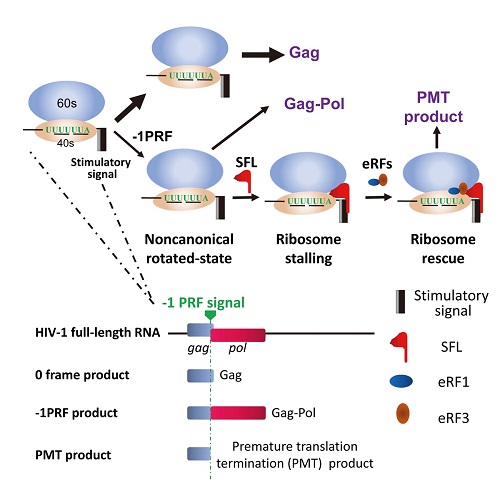Shiftless is a novel host antiviral factor that inhibits programmed -1 ribosomal frameshifting
A research article entitled "Regulation of HIV-1 Gag-Pol expression by Shiftless, an inhibitor of programmed -1 ribosomal frameshifting "was published online by Cell on January 24th, 2019. In this paper, Guangxia Gao's group of Institute of Biophysics, Chinese Academy of Sciences, reported a novel host antiviral factor named Shiftless that inhibits programmed -1 ribosomal frameshifting (-1PRF).
The genome sizes of viruses are usually relatively small. To increase information content of the genome, many viruses employ a translation recoding mechanism dubbed programmed ribosomal frameshifting. Translating ribosomes pause at -1PRF signal. While most ribosomes move on in the original reading frame, a small proportion slip back one nucleotide to translate in a new frame, resulting two protein products differing at the C-termini. HIV-1 uses -1PRF to produce Gag and Gag-Pol, which are both required for viral replication.
The -1PRF mechanism exists in all domains of life. In eukaryotes, -1PRF may also result in a premature stop codon, which could lead to the degradation of the mRNA. The -1PRF mechanism plays an important role in the post-transcriptional regulation of gene expression. However, how -1PRF is regulated by host factors is largely unknown.
Gao lab has been focusing on the molecular mechanism underlying virus-host interactions. To identify host factors that inhibit -1PRF, they first demonstrated that type I interferon can inhibit the expression of Gag-Pol, the -1PRF product of HIV-1. They then screened interferon-stimulated genes (ISG) for their activity to inhibit Gag-Pol expression, and identified Shiftless (originally named C19orf66). Shiftless displayed considerable inhibitory activity against all the tested -1PRF from both viruses and cellular genes, indicating that it is a broad-spectrum -1PRF inhibitor.
To explore the mechanism of Shiftless, they analyzed the interactions of Shiftless with the -1PRF RNA and translating ribosomes, two key players in the process of -1PRF. Shiftless interacted with both. Based on these results, they reasoned that Shiftless binding to the translating ribosomes and RNA simultaneously might render the ribosome stuck in a non-productive state, stalling on the RNA. The stalled ribosome should be rescued by the quality control mechanism, leading to premature translation termination. Using a sensitive reporter system, they detected the premature translation termination product, proving their hypothesis. They further demonstrated that the premature translation termination was executed by the host tranlsation release factors eRF1 and eRF3.
Based on these results, the authors proposed a working model for Shiftless to inhibit -1PRF (see the figure below). Shiftless interacts with the -1PRF signal RNA and the translating ribosome, and thereby causes ribosome stalling at the -1PRF site. Furthermore, Shiftless recruits the translation release factors eRF1-eRF3 to rescue the stalled ribosome, resulting in the production of premature translation termination (PMT) product. Since -1PRF is a widely used mechanisms, these results have far reaching implications that may impact many different fields.
This work was supported by grants from Chinese Academy of Sciences, National Health Commission, Ministry of Science and Technology, and National Natural Science Foundation of China.

Figure Working model for SFL to inhibit the -1PRF of HIV-1
(Imaged by Dr: Gao Guangxia’s group)
Article link: https://www.cell.com/cell/fulltext/S0092-8674(18)31644-1
Contact: Guangxia Gao, Ph.D.
Principal Investigator
CAS Key Laboratory of Infection and Immunity
Institute of biophysics, Chinese Academy of Sciences
Beijing100101, China
Tel: (86)-10-64888545
Email: gaogx@moon.ibp.ac.cn
(Reported by Dr. Gao Guangxia’s group)

